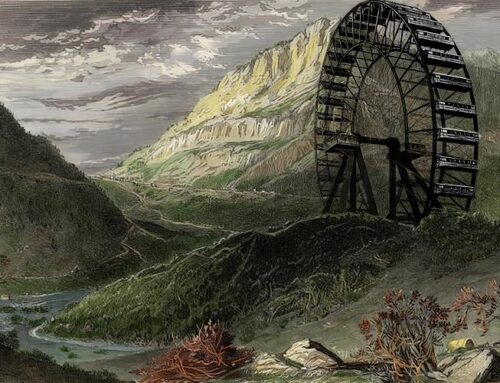
An advertisement for Blooker’s Cocoa from Harper’s Weekly in 1893.
This is a good day to enjoy a cup of hot cocoa and think about the 1893 World’s Fair. In a contemporary magazine advertisement promoting their distribution of Blooker’s Dutch Cocoa, the Franco-American Food Company offered this copy:
“The Columbian Exposition will soon be a thing of the past. Thousands of people who have visited the White City will remember the Blooker exhibit as they sip their cup of cocoa in the morning, and so by a series of reminiscences will recall all the other conspicuous features of the fair.” [Harper’s Weekly 1893]

The windmill exhibit was located on the southeastern grounds of the 1893 World’s Fair. [Image from The Vanishing City (Laird & Lee, 1893).]
Blooker’s Dutch Cocoa Windmill and House
One of the more conspicuous features of the 1893 World’s Columbian Exposition was the windmill exhibit, located in the southeast part of the fairgrounds, nestled between the Agricultural Building, South Pond, and Intramural Rail track. Erected near the entrance to the exhibit was a quaint reproduction of an ancient Amsterdam mill.
Constructed by the Blooker Cocoa Company, the structure was built using old-style German brick with imitation stone trimmings. On top was erected the wooden tower for an old-fashioned Dutch wind mill. During the Fair, the mill actually ground cocoa on site for use to make free cocoa drinks for visitors.
The curious cocoa house was “built and furnished to illustrate the surroundings of a burgher of moderate means, and refined tastes. The furniture and pottery are essentially Dutch, and of superior quality, and there are girls who serve the cocoa dressed in the national costumes of the Netherlands as worn in early days.” [Bancroft, 397]
“It will be a pleasure to all Hollanders visiting the World’s Fair to see this old Dutch windmill,” wrote the Chicago Tribune. “To them it will be the means of warming the Dutch cockles of their Dutch hearts. It will also be an attraction to the millions who never saw anything of the kind only in picture books and illustrated stories.” [“Dedicate the Mill”]

An illustration of Blooker’s cocoa mill. [Image from White, Trumbull; Igleheart, William World’s Columbian Exposition Chicago, 1893 (J. W. Ziegler, 1893).]
Real or Replica?
The image caption in the advertisement above notes that Blooker’s original 1806 windmill was “transferred to the World’s Columbian Exposition.” In contrast, other contemporary sources indicate that the structure in Jackson Park was a reproduction of the original mill. “It is an exact copy of one that stood in Amsterdam in 1806,” notes one Columbian Exposition history. [Vanishing City]
Construction began on February 8, 1893, reported the Chicago Tribune, on what the paper described as “a reproduction of the Blooker factory in Holland.” [“Progress in Other Departments”] A little more than a month later, when the paper reported on March 26 dedication ceremony for Blooker’s cocoa house, it made clear that this was the original Dutch windmill, transported to Chicago from Holland:
“In 1806 the house of Blooker, Amsterdam, Holland, erected a cocoa wind mill, one of the ancient history kinds that Don Quixote fought with. It now stands in Jackson park. Since the time of its construction this mill has remained in the Blooker family. It is still sound and in perfect working order.
When the World’s Columbian Exposition was launched, George Van Hensden, representative of the house in Chicago, conceived of the idea that it would please the thousands of Dutch-Americans to see an old cocoa wind mill at the fair, so he induced Mr. Blooker to take the machinery out of the old structure and send it on to Chicago.
A. Verdonk, a Dutch mill builder, and his two sons were brought over to put up the mill building exactly as they would in Holland. They have so far completed the work that recently a number of representative Hollanders assembled in the tower and with appropriate ceremonies dedicated the mill to exhibition purposes …
The machinery of this old mill, every shaft, wheel, and post, is made of oak, and time has only served to harden it so thoroughly that the wear of long use is scarcely noticeable. Mr. Van Hensden has arranged to keep the mill in operation every day grinding cocoa, which will be prepared and served to visitors free of charge. For this purpose a room in the building will be fitted up in sixteenth century style, supplied with antique furniture brought over from Holland expressly for the purpose. Dutch girls, dressed in native Holland costumes, will be in attendance.” [“Dedicate the Mill”] Windmill researcher Thomas Haskell confirms on his website Illinois Windmills that Blooker’s cocoa house structure was a replica of De Vriendschap (The Friendship) windmill in Amsterdam.

A cup of Blooker cocoa
What happened to the structure after the close of the World’s Columbian Exposition is not known, but the product inside it is still with us. Blooker cocoa is manufactured today in the Netherlands and appears to be widely available for purchase online.
Enjoy some warm thoughts of the 1893 World’s Fair.

A J. & C. Blooker trade card from the 1893 World’s Columbian Exposition.
SOURCES
Bancroft, Hubert Howe The Book of the Fair. The Bancroft Company, 1893.
“Dedicate the Mill: Hollanders Raise Flags on a Cocoa-Grinder at the Fair” Chicago Daily Tribune Mar. 26, 1893, p. 12.
“A Magnificent Show” Farm Implement News Oct. 12, 1893, p. 19.
“Progress in Other Departments” Chicago Daily Tribune Feb. 8, 1893, p. 2.
The Vanishing City: A Photographic Encyclopedia of the World’s Columbian Exposition. Laird & Lee, 1893.






Leave A Comment